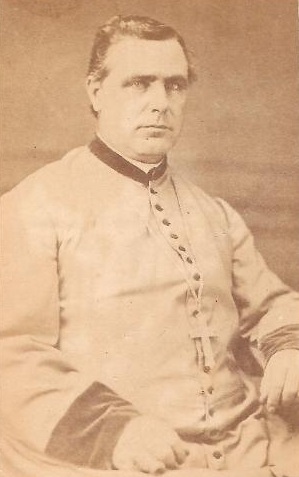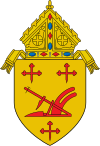
St Patrick's Pontifical University, Maynooth, is the "National Seminary for Ireland", and a pontifical university, located in the town of Maynooth, 24 km (15 mi) from Dublin, Ireland.

Virginia Theological Seminary (VTS), formally called the Protestant Episcopal Theological Seminary in Virginia, located at 3737 Seminary Road in Alexandria, Virginia is the largest and second oldest accredited Episcopal seminary in the United States.

The Missionaries of the Precious Blood is a Catholic community of priests and brothers. The society was founded by Saint Gaspar del Bufalo in 1815.

Bangor Theological Seminary was an ecumenical seminary, founded in 1814, in the Congregational tradition of the United Church of Christ. Located in Bangor, Maine, and Portland, Maine, it was the only accredited graduate school of religion in Northern New England

Walnut Hills United Presbyterian Church is a historic church tower in the Walnut Hills neighborhood of Cincinnati, Ohio, United States. The last remnant of a landmark church building, it was designed by a leading Cincinnati architect and built in the 1880s. Although named a historic site a century after its construction, the building was mostly destroyed after extensive neglect caused restoration to become prohibitively expensive.
Carthagena is an unincorporated community in Mercer County, Ohio, United States. Established by African Americans, it was home to an agricultural and industrial boarding school for African American and Indian orphans. It has an elevation of 909 feet (277 m) and is located at 40°26′12″N84°33′36″W.

Joseph Gregory Dwenger C.P.P.S was an American prelate of the Roman Catholic Church. He served as bishop of the Diocese of Fort Wayne in Indiana from 1872 to 1893.

St. Henry's Catholic Church is an historic Roman Catholic church in St. Henry, Ohio, United States. Built in the late nineteenth century, it remains the home of a functioning congregation, and it has been recognized as a historically significant building because of its architecture.

The DeCurtins family, sometimes written De Curtins, were involved in Midwestern U.S. church architecture. Anton De Curtins was a Swiss immigrant who lived in Carthagena, Ohio and designed several Gothic Revival architecture churches in Mercer County, Ohio, as well as rectories, schools and residences. Anton was a master carpenter, and with his sons he directed the building and decorating of the steepled churches that "still shine across the surrounding flatness of the Northwestern Ohio landscape".

St. John the Baptist Catholic Church is a historic Roman Catholic church in Marion Township, Mercer County, Ohio, United States. Located in the unincorporated community of Maria Stein, it is the home of an active congregation and has been recognized as a historic site because of its well-preserved late nineteenth-century Romanesque Revival architecture.

Holy Family Catholic Church is a historic Roman Catholic church in Wayne Township, Darke County, Ohio, United States. Located in the unincorporated community of Frenchtown, it houses an active congregation, and it has been accorded historic site status because of its well-preserved Gothic Revival architecture.

Precious Blood Catholic Church is a Roman Catholic parish in Chickasaw, Ohio, United States. Erected in 1903 and still an active parish, the church historically owned two buildings constructed in its early years that have been designated as historic sites.

St. Aloysius Catholic Church is a historic Roman Catholic church in Carthagena, an unincorporated community in Marion Township, Mercer County, Ohio, United States. Built in the late nineteenth century, it remains the home of an active parish, and it has been designated a historic site because of its well-preserved architecture.

The Nativity of the Blessed Virgin Mary Catholic Church is a historic Catholic church in Cassella, an unincorporated community in Mercer County, Ohio, United States. One of several Catholic churches in Marion Township, it has been designated a historic site because of its well-preserved nineteenth-century architecture.

St. Rose's Catholic Church is a historic Catholic church in St. Rose, an unincorporated community in Marion Township, Mercer County, Ohio, United States.

Immaculate Conception Catholic Church is a parish of the Roman Catholic Church in Celina, Ohio, United States. Founded later than many other Catholic parishes in the heavily Catholic region of western Ohio, it owns a complex of buildings constructed in the early 20th century that have been designated historic sites because of their architecture. Leading among them is its massive church, built in the Romanesque Revival style just 43 years after the first Catholic moved into the city: it has been called northwestern Ohio's grandest church building.

The Sisters of the Precious Blood is a Roman Catholic female religious order founded in Grisons, Switzerland, in 1834 by Mother Maria Anna Brunner. Precious Blood Sisters form an active apostolic congregation with sisters currently serving in the United States, Chile, and Guatemala. The congregation's mission statement reads: "Urged by the redeeming love of Jesus the Christ and rooted in Eucharistic prayer, we Sisters of the Precious Blood proclaim God's love by being a life-giving, reconciling presence in our fractured world." Members of the community are called to live out Precious Blood Spirituality regardless of their chosen ministry or daily work. Sisters have served in education, pastoral ministry, health care, social services, and various other fields.

All Saints Catholic Church is a Roman Catholic faith community comprising various historical communities, including St. Boniface Catholic Church in New Riegel, St. Nicholas Catholic Church in Frenchtown, and Ss. Peter & Paul Catholic Church in Alvada, Ohio. The community was constituted in 2005 when Bishop Leonard Blair of the Roman Catholic Diocese of Toledo consolidated these communities, leading to the closure of the churches in Frenchtown and Alvada. As a result of these closures, "All Saints" is now synonymous with what was previously known as St. Boniface Catholic Church and its associated rectory, convent, school and cemetery on North Perry Street in New Riegel, Ohio
Emlen Institution for the Benefit of Children of African and Indian Descent was an agricultural and industrial boarding school for African American and Native American Children in the United States. It was established in a bequest by Samuel Powers Emlen Jr., a prominent Quaker who lived in Burlington, New Jersey who died in 1837. Emlen left $20,000 for the "education, maintenance and instruction in school learning and in agriculture and mechanical trades or arts, of free male orphan children of African or Indian descent." It was established in Ohio with the acquisition of an existing manual labor school for African Americans in Carthagena, Ohio before relocating to Pennsylvania. It is unclear when it ceased operating. Several buildings from one of its locations in Pennsylvania are extant.






















